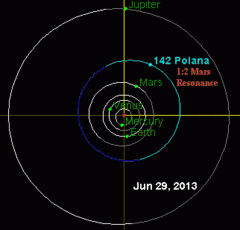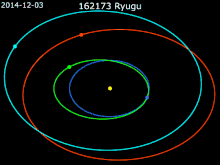142 Polana
Polana (minor planet designation: 142 Polana) is a very dark asteroid from the asteroid belt. It was discovered by Johann Palisa on January 28, 1875, and named after the city of Pola (now Pula, Croatia), home of the Austrian Naval Observatory where he made the discovery.[1]
 Polana is in a 1:2 resonance with Mars | |
| Discovery[1] | |
|---|---|
| Discovered by | J. Palisa |
| Discovery site | Austrian Naval Obs. |
| Discovery date | 28 January 1875 |
| Designations | |
| (142) Polana | |
| Pronunciation | |
Named after | Pula |
| Asteroid belt | |
| Orbital characteristics[1] | |
| Epoch 31 July 2016 (JD 2457600.5) | |
| Uncertainty parameter 0 | |
| Observation arc | 117.65 yr (42971 d) |
| Aphelion | 2.7444 AU (410.56 Gm) |
| Perihelion | 2.0934 AU (313.17 Gm) |
| 2.4189 AU (361.86 Gm) | |
| Eccentricity | 0.13457 |
| 3.76 yr (1374.1 d) | |
Average orbital speed | 19.07 km/s |
| 140.92° | |
| 0° 15m 43.128s / day | |
| Inclination | 2.2379° |
| 291.27° | |
| 292.00° | |
| Physical characteristics | |
| Dimensions | 55.29±1.6 km[1] 55.3 ± 1.6[2] |
| 9.764 h (0.4068 d) | |
| 0.0451±0.003[1] 0.045 ± 0.003[2] | |
| F/B[1] B−V=0.621±0.022[1] U−B=0.236±0.035[1] | |
| 10.27[1] | |
It is a major member of the eponymously named Polana family, which is a subgroup of the Nysa family.[3] The asteroid has an estimated diameter of about 55.3 km and a low albedo of 0.045.[2] It is orbiting at a distance of 2.419 times the separation of the Earth from the Sun, with an orbital period of 3.76 years and an eccentricity of 0.14.
In the Tholen classification scheme, Polana is a primitive carbonaceous asteroid of type F, which is a subdivision of more common C-type.[1] Under the SMASS classification taxonomy, Polana is listed as a B-type asteroid; a group that combines both the Tholen B and F types. The spectrum of this object suggests the presence of magnetite (Fe3O4), which gives it the spectrally blue coloration that is a characteristic of this SMASS class.[4]

Sun · Earth · 162173 Ryugu · 142 Polana · 495 Eulalia
Mars resonance
Polana is in a 1:2 orbital resonance with Mars, meaning that Polana orbits the Sun once for every two orbits that Mars completes. This resonance helps protect the asteroid from orbital erosion: the orbital eccentricities of the resonant asteroids are clearly greater than the non-resonant asteroids. There is a peak in the number of asteroids located at 2.419 AU from the Sun.[6] In spite of strong perturbations caused by the passing of both Jupiter and Mars, the 1:2 Mars resonance brings about stability for billions of years. There are up to 1,500 asteroids in this resonance, and the resonance between Polana and Mars will strengthen over the next million years due to Polana transitioning into a strong libration period with Mars.[7]
References
- "142 Polana". JPL Small-Body Database Browser. August 14, 2007. Retrieved May 12, 2016.
- Lazzarin, M.; Barbieri, C.; Barucci, M. A. (December 1995), "Visible Spectroscopy of Dark, Primitive Asteroids", Astronomical Journal, 110: 3058, Bibcode:1995AJ....110.3058L, doi:10.1086/117747
- Cellino, A.; et al. (August 2001). "The Puzzling Case of the Nysa-Polana Family". Icarus. 152 (2): 225–237. Bibcode:2001Icar..152..225C. doi:10.1006/icar.2001.6634.
- Yang, Bin; Jewitt, David (September 2010), "Identification of Magnetite in B-type Asteroids", The Astronomical Journal, 140 (3): 692–698, arXiv:1006.5110, Bibcode:2010AJ....140..692Y, doi:10.1088/0004-6256/140/3/692
- S. Sugita; et al. (March 19, 2019). "The geomorphology, color, and thermal properties of Ryugu: Implications for parent-body processes". Science. 364 (6437): eaaw0422. doi:10.1126/science.aaw0422. hdl:1893/29363. PMID 30890587.
- Gallardo, Tabaré (2007). "A new population of asteroids: the resonants 1:2 with Mars". Montevideo, Uruguay: Institute of Physics, Faculty of Sciences. Retrieved December 17, 2009.
- Gallardo, Tabaré (2009). "A New Dynamical Population of Asteroids" (PDF). Revista Mexicana de Astronomía y Astrofísica (Serie de Conferencias). 35: 21–22. Retrieved December 17, 2009.
External links
- Asteroids inside the resonance 1:2 with Mars, Tabaré Gallardo
- 142 Polana at AstDyS-2, Asteroids—Dynamic Site
- 142 Polana at the JPL Small-Body Database
